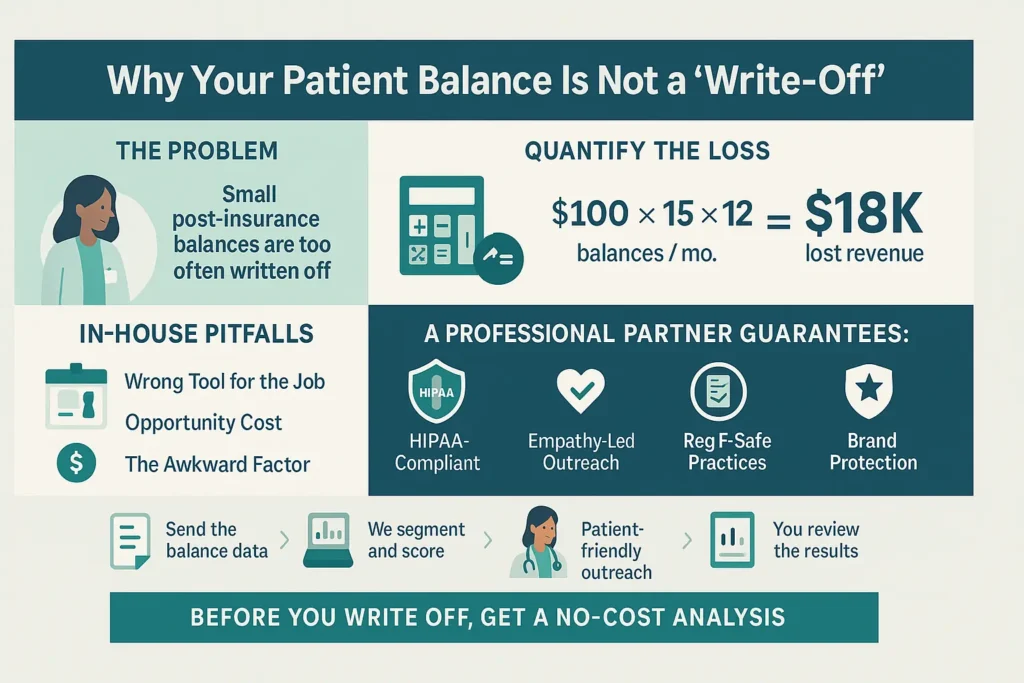The Problem You’re Staring At Every Day
It’s the $85 co-pay that never arrived. The $150 post-insurance balance that slipped past three statements. Click “write-off” and move on — tempting, because your team is already stretched. But those “small” balances are not harmless. They add up, they drain cash, and they train patients to treat balances as optional.
Our thesis: These patient portions are recoverable — without risking HIPAA or your online reputation — when handled by a professional, patient-friendly partner.
Death by a Thousand Cuts (Quantify the Loss)
One $100 write-off? A rounding error.
Fifteen of them a month? $18,000 a year.
That’s a new dental chair. That’s end-of-year bonuses. That’s the patient-intake software you keep postponing. This isn’t “the cost of doing business.” It’s a preventable leak in your AR ledger.
Quick math: 15 balances/month × $100 × 12 months = $18,000 in lost revenue.
Why the In-House “Solution” Backfires
1) Wrong tool for the job.
Front-desk teams excel at care, scheduling, and a great check-in. They’re not trained for compliant collections conversations — nor should they be asked to be.
2) Opportunity cost.
Every 20 minutes spent chasing a $100 balance is 20 minutes not spent verifying insurance, booking higher-value procedures, or smoothing the patient flow.
3) The awkward factor.
The person who greets a patient shouldn’t also make the overdue-balance call. It strains the relationship and hurts morale.
The Brand-Risk Myth vs. Professional Reality
Let’s be direct. Your biggest fear is hiring someone who will harass patients and trigger one-star reviews. Fair. That old model still exists in movies — not in our shop.
How a modern, compliant partner operates:
-
HIPAA, fully.
We don’t just say “HIPAA-aware.” We run on it. PHI handling, storage, and access are locked down. Staff training is mandatory and documented. -
Empathy-led outreach.
These are your patients, not “accounts.” We use respectful, negotiation-based conversations to set up realistic payment plans and resolve balances without friction. -
Your brand, protected.
We act as a third-party buffer so your front desk doesn’t have to. Our scoreboard has two numbers: recovery rate and brand integrity. If either drops, we fix the process. -
Reg F–safe contact methods.
Email/SMS/call cadence is documented and compliant. Opt-outs honored. Every step is auditable.
What Changes When You Stop Writing Off “Small” Balances
-
Cash flow improves quickly because younger accounts resolve faster.
-
Team morale rises when awkward money calls move off the front desk.
-
Patients cooperate more with a neutral, professional third party.
-
Leaders get clarity from clean reporting inside your practice management software and our client portal.
What This Looks Like in Practice
-
You send a simple export from your practice management software (no PHI beyond what’s required).
-
We score and segment balances by age, amount, and likelihood to resolve.
-
We start early-stage, patient-friendly outreach — documented, HIPAA-compliant, Reg F–safe.
-
You see live results: time-to-first-contact, promises-to-pay, dollars recovered, and complaint rate (kept near zero).
Objections You Might Be Thinking
-
“It’s only $100.”
Not when there are dozens of them, every month. -
“My office manager can call.”
They can. But should they? Their time is worth more — and patients respond better to a neutral third party. -
“What if someone leaves a bad review?”
Our approach is designed to avoid it. Courteous language, flexible plans, and documented compliance protect your brand.
Bottom Line — These Aren’t “Bad Debts.” They’re Uncollected Revenue.
You don’t have a “bad patient” problem. You have a process problem — one that a compliant, patient-friendly recovery partner can fix.
Before you write off another dollar, let’s run a no-obligation analysis of your “bad debt” ledger. We’ll show — using your numbers — how much revenue is recoverable, how quickly, and with what contact cadence.
Send a de-identified export of post-insurance balances aged 30–180 days. We’ll return a clear, data-backed recovery projection and a recommended plan your team can approve — or decline — with confidence.
